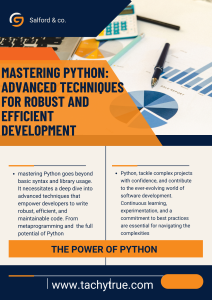Mastering Python: Advanced Techniques for Robust and Efficient Development
Comunication, Data sciencePython, with its elegant syntax and extensive libraries, has become a cornerstone of modern software development. From web applications and data science to machine learning and automation, Python’s versatility is undeniable. However, proficiency in Python extends beyond basic syntax and library usage. Mastering the language requires delving into advanced techniques that empower developers to write robust, efficient, and maintainable code. This article explores several advanced Python concepts that will elevate your programming skills and unlock the full potential of this powerful language.

1. Metaprogramming and Decorators:
Metaprogramming, the ability of a program to manipulate its own structure during runtime, unlocks powerful capabilities. Decorators, a form of metaprogramming, allow you to modify or extend the behavior of functions or classes without altering their source code. They are particularly useful for tasks like logging, authentication, and performance profiling.
For example, a decorator can be used to measure the execution time of a function:
import time
def timer(func):
def wrapper(*args, **kwargs):
start_time = time.time()
result = func(*args, **kwargs)
end_time = time.time()
print(f"{func.__name__} executed in {end_time - start_time:.4f} seconds")
return result
return wrapper
@timer
def my_function():
time.sleep(1)
my_function()
This decorator encapsulates the timing logic, making it reusable across multiple functions. Understanding decorators empowers you to write cleaner and more modular code.
2. Generators and Iterators:
Generators and iterators are essential tools for handling large datasets efficiently. Generators, created using the yield keyword, produce values on demand, rather than storing the entire dataset in memory. This lazy evaluation is crucial for processing large files or infinite data streams.
def fibonacci_generator(n):
a, b = 0, 1
for _ in range(n):
yield a
a, b = b, a + b
for num in fibonacci_generator(10):
print(num)
Iterators, on the other hand, are objects that implement the iterator protocol, allowing you to traverse through collections. Understanding generators and iterators is crucial for writing memory-efficient and scalable applications.
3. Context Managers and the with Statement:
Context managers, implemented using the with statement, provide a clean and reliable way to manage resources like files, network connections, and locks. They ensure that resources are properly acquired and released, even in the event of exceptions.
with open("my_file.txt", "w") as f:
f.write("Hello, world!")
The with statement guarantees that the file is closed, regardless of whether any errors occur within the block. Context managers enhance code readability and prevent resource leaks.
4. Asynchronous Programming with asyncio:
Asynchronous programming, enabled by the asyncio library, allows you to write concurrent code that can handle multiple tasks simultaneously without blocking. This is particularly useful for I/O-bound operations like network requests and file operations.
import asyncio
import aiohttp
async def fetch_url(url):
async with aiohttp.ClientSession() as session:
async with session.get(url) as response:
return await response.text()
async def main():
urls = ["https://www.google.com", "https://www.example.com"]
tasks = [fetch_url(url) for url in urls]
results = await asyncio.gather(*tasks)
for result in results:
print(result[:100])
asyncio.run(main())
Asynchronous programming significantly improves the performance of applications that rely on concurrent operations.
5. Advanced Data Structures and Algorithms:
Beyond basic data structures like lists and dictionaries, Python offers a range of advanced data structures, such as collections.deque, collections.OrderedDict, and heapq, that provide specialized functionalities. Understanding these data structures and their associated algorithms is crucial for solving complex problems efficiently.
For instance, collections.deque provides fast appends and pops from both ends, making it ideal for implementing queues and stacks. The heapq module provides heap-based priority queue implementations, useful for tasks like scheduling and graph algorithms.
6. Type Hinting and Static Analysis:
Type hinting, introduced in Python 3.5, allows you to specify the expected types of variables, function arguments, and return values. While Python is dynamically typed, type hints enhance code readability and enable static analysis tools like mypy to detect type errors before runtime.
def greet(name: str) -> str:
return f"Hello, {name}!"
Type hints improve code maintainability and reduce the likelihood of runtime errors.
7. Effective Testing and Debugging:
Writing comprehensive unit tests and employing effective debugging techniques are essential for building reliable software. The unittest and pytest frameworks provide powerful tools for testing Python code. Debugging tools like pdb and IDE debuggers allow you to step through code, inspect variables, and identify errors.
8. Understanding Python’s Internals:
Delving into Python’s internals, such as the Global Interpreter Lock (GIL), memory management, and C extensions, provides a deeper understanding of how the language works. This knowledge can help you optimize performance and avoid common pitfalls.
Mastering these advanced Python techniques requires dedication and practice. By exploring these concepts and applying them to real-world projects, you can elevate your Python programming skills and become a more effective and efficient developer. Continuous learning and experimentation are key to unlocking the full potential of Python and staying ahead in the ever-evolving world of software development.
Conclusion
In conclusion, mastering Python goes beyond basic syntax and library usage. It necessitates a deep dive into advanced techniques that empower developers to write robust, efficient, and maintainable code. From metaprogramming and asynchronous programming to advanced data structures and effective testing, the concepts discussed in this article represent a toolkit for elevating your Python skills. By embracing these techniques, you can unlock the full potential of Python, tackle complex projects with confidence, and contribute to the ever-evolving world of software development. Continuous learning, experimentation, and a commitment to best practices are essential for navigating the complexities of modern software development and harnessing the true power of Python.
